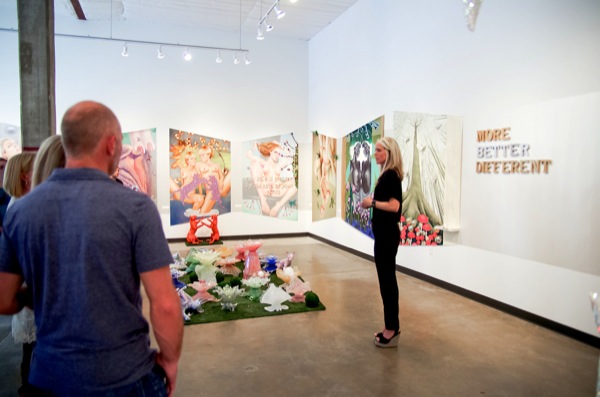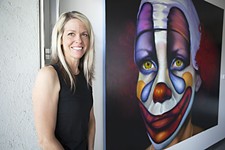"Pillow" Talk
Terri Thomas on what's behind the sex in her Big Medium art show
By Seth Orion Schwaiger, 10:45AM, Thu. Jun. 5, 2014
Terri Thomas' solo exhibition "Pillow Book as Inheritance" is challenging for many viewers, punter and scenester alike, though perhaps for different reasons. That inspired me to speak with the artist about the show. The interview began as informal conversation followed by elaboration and clarification over email.

Austin Chronicle: Seemingly, every autobiography and self-portrait has had accusations leveled at it concerning narcissism and self-importance, regardless of author. This is not always warranted. However, your exhibition goes a bit further, it's not only loosely autobiographical, but also sexual in an overt way. I can't help but ask how much this show is about exhibitionism rather than the exhibit. Do you feel that this show is a performance? Do you enjoy the feeling of being at the center of attention and how does that play into the work?
Terri Thomas: Lots of questions here … Yes, in a way, the exhibit from beginning to end is intended to act as a performance, an interactive book. While the work in this current series may be laden with less important autobiographical narratives, my use of my own image is purely reference material. It is not meant to communicate my personal identity or be about me. In my art talk, I mentioned that my recent work heavily relies on strategies, such as artifice, digital inversion, the mask, masquerade (painting in wigs, props, childlike sexual codes of dress, tapestries, that signify "this is a stage") or a hybridization (combining a likeness of my face with appropriated images of porn or consumer imagery), etc. This pretense or concealment is intended to convey that these representations are not about personal identity or my being at the center of attention, but rather the performance of identity, gender, or pleasure, etc. in order to make commentary, inquiry, or act as a mirror within this loaded representational structure.
The explicit element in my work started in art school with an examination of the patriarchal tradition of painting the nude combined with all the feminist literature I was reading. This set me on the trajectory of female representations and an interest in third-wave feminism. Pertaining to sex, this series of work investigates relations of power and sexual identity convoluted by a commercially driven culture. It brings to the surface dichotomous aspects such as: feminism vs. feminist desire, the gaze vs. "the matrixial gaze," emancipation vs. subjugation, consciousness vs. false consciousness, and agency vs. passivity. Dual narratives in the work are inspired by my readings of contrasting feminist theories. Well known authors such as John Berger, Laura Mulvey, Ariel Levy, and Naomi Wolf are grounded in their notions of "the male gaze," scopophilia, critique of the porn industry, or constructions of beauty, identity, and gender. Conversely, other feminist scholars attempt to undermine conventions with intriguing biographical accumulations of confessions of desire depicted by highly academic, conscious, autonomous third-wave feminist artists and writers who are engaged in sex work, are lesbian, or simply abhor the no-sex, no-penetration feminists who create rules for other women and act like moral beacons. In order to be agonistic with this work, I bring both sides of this critique to the surface.
While exhibitionism is not something I consider in the creation of the work, I certainly see how it fits. I did, however, intend a sensationalistic, excessive, crafted quality with this show. I felt that this spectacle was needed to both reinforce and ridicule the subject matter, attract and repel, help build curiosity with the upcoming performance and support the lures and traps you see in the paintings.

AC: Your work is clearly and unabashedly about sex. What are your opinions about how sex is portrayed and consumed in the culture we live in?
TT: There is a lot I could say about this and to be clear, the work is about the tension existing within a complacent and mediatic world, which is shaping the perceptions of our culture’s youth through the selling of sex and by creating absurd linkages to sexuality. Reality TV is making us dumber and less aware of the consequences to having promiscuous sex; men and women clamor and compete to be married to the next Bachelor or Bachelorette. Meanwhile, advertising, video games, music videos, and porn continue to endorse fabricated "ideals." My show in 2006 titled "U-genics" explored these themes, depicting the effects and the atrocities we commit upon ourselves to achieve unobtainable standards of beauty or perfection, while emulating the sexual behaviors ascribed by the media.
Another instance you might relate to better is the recent botched execution that happened this past week in Oklahoma. Here you have a man, constrained to a gurney, waiting to be executed with a room full of people watching. What is supposed to be a quick and painless death turns into over 40 minutes of torture, because the IV that was placed in the man’s "groin" to administer the poison became loose and went undetected because his "groin" had been covered by a sheet. So, in our society, we can observe a man being tortured or put to death by other men, but yet we are too squeamish to see his naked body?
Our society still has many issues around the topic of sex. My work addresses this with biting humor by satirizing our Western sexual vernacular and visually elaborating on the euphemism, pun, idioms, double entendre, and kitsch used to discuss sex in our culture.
AC: In your paintings in particular, it seems difficult to find the criticism of how sexuality is presented or sold to us. To me, the works seem more complacent in this type of portrayal, lifting images more or less directly from porn and hiding the identities of the primary actors by the addition of your own face. Even though these works are not for sale, they seem to work in a commercial way by bolstering your own image as an edgy artist and lending clout to other works that are for sale in the space. Do you feel that these works are also "selling sex" to your audience?
TT: While I believe the title of each painting related to each narrative clearly reveals elements of jesting or cynicism, I understand your difficulty to pinpoint the criticism. It is important for me to create ambiguity and sidestep purely ironic forms of subversion, bringing the dual narrative outward by using strategies to convey the contrast in the work. In the paintings, there is the hybridization, twin (and other) stereotypes, glass and crystal artifice nailed, glued, hanging, obscuring, and censoring the oil-painted surfaces. In addition, I think it’s important to put this work into context. I’m creating within and reacting to a very "anti- aesthetic" art world/framework. Strategies of beauty are used to appear as both a reflection and a criticism. The shine, bling, and skill of the paint and materials will attract and invite openness, playfulness, celebration, and create accessibility for some viewers. For others, this excess will be repelling, a tool to denote the defacement, satire, and critique of the replicated, vacant subjects.

Likewise, the sculptures contain a dual narrative. On one hand, the cat sculptures are intended to be devotional and stand for feminine power. On the other, they are satirical, commenting on how the media has taken sexuality and absurdly linked it to ideas of class, beauty and privilege. These contrary pussy sculptures are an important part of this book assemblage, both echoing and informing the ambiguous yet conflicting paintings they embellish. With this duality, I wanted to divide discernment within the crowd, trusting that everyone would bring a different level of consciousness, experience, education, empathy, or appreciation to the work.
AC: In your artist talk [at Big Medium on May 3], you mentioned that you didn't feel right objectifying another woman for your art by painting anyone other than yourself in these compromised poses, but you also mentioned that these works were stand ins for everywoman. Do you then feel that these works are objectifying every woman? What is your stance on objectification?
TT: I think you have this partially right… So far, I’ve resisted painting other women or men as a way to avoid objectifying another, and to put only myself at risk with this type of representation. Personally, I think it just makes for more interesting work knowing someone is putting themselves at stake, rather than commenting from the safety of the periphery. Also, I think of my work as a mirror, inviting the viewer to tap into a psyche or situation to allow them to try on the contrast, struggle, freedom, contradiction, or whatever it is that is reflected back.
AC: In your artist talk, you mentioned a duality between existentialism and "the other." Can you explain this and tell us how it applies to your work?
TT: In my first solo exhibition in Washington D.C., I created a series of large paintings that acted as a continuum. The series of eight paintings were shown again in my solo show in Austin at Volitant Gallery. The string of paintings were titled Indivi/duality and was dichotomous from end to end, as well as within each individual painting. The far left portrait depicted a single, vulnerable figure on a blue ground. And the far right depicted a more cliched, stereotyped, double self-portraiture of naked women on red satin (one protecting the other). The thematic intentions of the show informed this work and vice versa. The front entrance of the exhibit conveyed a Utopian Spectacle, with a red carpet performance and life-sized idyllic portrayals. While the back of the exhibit, containing videos and photos of real, excruciating, and self-mutilating depictions, revealed the Spectacle of Anxiety that lay inherently within. So this continuum of paintings became the narrator of the installation from front to back (or right to left) reflecting dualities, such as: Utopian/Anxiety, Public/Private, Fantasy/Reality, Nurture/Nature, Concealing/Revealing, Otherness/One-ness – which led to an interesting binary: Otherness/Duality vs. Oneness/Existentialism? Since, creating this distinction for myself, I have wondered, "As a twin, do I empathetically try to tap into the notion of existentialism, as often as singletons try to tap into the idea of being a twin?"
AC: I don't feel uncomfortable around your work, but I'm aware that others do, and I think that's understandable. How do you want or expect your viewers to feel in the gallery space?
TT: I love for them to have strong feelings one way or another, just feel something! My work is about duality and contrast. I go toward the tension, conflict, and contradiction in things and present ideas in a conflicting, confronting, agonistic way to invite the viewer to grapple with similar issues. With this series in particular, it was designed to divide discernment with viewers, and elicit a love/hate reaction to the work. It would be the only way I could see the performance at the end of the show working the way I hope.
AC: How do you feel your work relates to feminism and femininity?
TT: Well, I’ve stated a lot about my politics above. But you know the saying: There are as many definitions of feminism as there are women. And… I think it helps grow consciousness and forwards humanity if our youth can learn of the smoother road that has been paved for them by brave radicals. My work can responsibly expand the roles, representations, and ways of being for women. It is a stand for noncompliance, reinvention, self-expression, and autonomy for every individual.

AC: So, this sculptural work is an immaculate giant bird's head and bust sticking out of the wall with a cat clawing up at it. It was clearly time-consuming, covered with bling and faux fur. But essentially it's a big cock and pussy. How does this relate to the title Married to a Poem, Given Away in a Novel? You mentioned Keats?
TT: Yes, one night we were looking up famous quotes for my husband’s father’s tombstone. I looked up the 19th century romantic poet John Keats because I remembered loving his epitaph. Upon his own request, he would be placed under a stone with no name and no date, with only the words "Here lies One whose Name was Writ in Water." As I read on, I learned about a letter he had written to the only woman he had ever loved, explaining that all the other women that claimed to love him "would like to be married to a poem and be given away by a novel." Somehow I thought that the tragedy of a romantic, admired poet who never felt loved for who he truly was, but only for what others thought they could get from him, was a perfect title for this sensational, lusty centerfold.
AC: The exhibition seems to read from left to right around the room, starting with a sandcastle full of bling and phalluses, moving through the "education" of the pillow-book series, where the sculpted cat forms are introduced and gradually grow, then there's the work we just mentioned followed by "the age of coming," which seems like a pretty clear stand-in for an orgasm, and then there's this much larger mountain lion-sized… I hesitate to use the word "cougar" sitting on a plinth over which hangs the words "FUCK YOU DESERVE IT," In previous works, you've clearly drawn a parallel between yourself and this repeated feline. I have to wonder if you see this as the last chapter in a memoir. Do you see yourself as the cat? Do you feel like this final work is representative of you now? How does the text play into that?
TT: Interesting read. If the order was chronological, the centerfold would come in #2, after the sandbox. Next would be the coming of age. Last would be "Idle Predecessors." The type of feline is not important… mountain lion, bobcat, or puma doesn’t matter. The "beautiful pussies" are not intended to be representations of me personally, per se. They characterize aspects of that girl who adorns her body, enjoys being looked at, and can laugh at herself at the same time. They are aware and powerful… yet on some level affected.

AC: There will be a performance at the closing of the exhibition. Care to give the readers any ideas of what they'd be in for?
TT: In the press release, I referred to my performance as a "departure." This word was anticipated to have multiple meanings. Departure as in POD/point of departure, or creating a Divergence within the art world. And departure, as in creating my own theoretical exodus and thereby bequeathing my Notes of the Pillow to whomever happens to show up that day. Basically, the end performance is a "give away," a passing on of information. Although some of your readers might have an advantage here, I still hope for divided discernment or appreciation for the work. The event will be videotaped to later examine agency – who has it: the critic, dealer, artist, or viewer? - while observing the duality between object/subject relationships, giving and taking, scarcity and abundance, preservation and destruction.
AC: Now that the production of this show is complete, what’s happening in the studio? Do you have future exhibitions you are working on? In what ways will future works be different than the works in this show?
TT: After this show? All very boring stuff. (Laughs) Seriously, I am painting monumental masked faces, a series titled, Phren: Fragmentation and Resolve. Each painting will have a different set of formal elaborations that range from the abstract to the concrete, while challenging my sensibility’s natural gratifying "end point" with the work. The range of these physical marks and process intend to act as a metaphor for the splintering and restoring of the mind.
"Terri Thomas: Pillow Book as Inheritance" is on view through June 7 at Big Medium Gallery at Canopy, 916 Springdale. A closing performance begins at 8pm on Saturday, June 7. Gallery hours are Friday and Saturday, noon-6pm and by appointment. For more information, visit www.bigmedium.org.
A note to readers: Bold and uncensored, The Austin Chronicle has been Austin’s independent news source for over 40 years, expressing the community’s political and environmental concerns and supporting its active cultural scene. Now more than ever, we need your support to continue supplying Austin with independent, free press. If real news is important to you, please consider making a donation of $5, $10 or whatever you can afford, to help keep our journalism on stands.
Andy Campbell, June 6, 2014
Dec. 23, 2016
Feb. 5, 2016
Terri Thomas, Pillow Book as Inheritance









